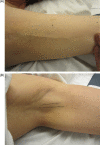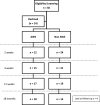Function, Shoulder Motion, Pain, and Lymphedema in Breast Cancer With and Without Axillary Web Syndrome: An 18-Month Follow-Up
- PMID: 29361075
- PMCID: PMC6692645
- DOI: 10.1093/ptj/pzy010
Function, Shoulder Motion, Pain, and Lymphedema in Breast Cancer With and Without Axillary Web Syndrome: An 18-Month Follow-Up
Abstract
Background: Axillary web syndrome (AWS) can develop following breast cancer surgery and presents as a tight band of tissue in the axilla with shoulder abduction.
Objective: The objectives were to determine the prevalence and natural history of AWS and the association between AWS and function, range of motion, pain, lymphedema, and body mass index (BMI).
Design: This study was a longitudinal prospective cohort study utilizing a repeated measures design.
Methods: Axillary web syndrome, function, shoulder range of motion, pain, and lymphedema (using circumference, bioimpedance spectroscopy, tissue dielectric constant) were assessed in women at 2, 4, and 12 weeks and 18 months following breast cancer surgery. Prevalence of AWS and the association with the measured outcomes were analyzed.
Results: Thirty-six women agreed to participate in the study. The cumulative prevalence of AWS was 50% (18/36) at 18 months following breast cancer surgery. AWS was identified as a risk factor for reduced function. Women with AWS had statistically reduced range of motion, lower BMI, and higher number of lymph nodes removed compared to the non-AWS group. Forty-one percent (13/32) of women had AWS at 18 months. AWS reoccurred in 6 women following resolution, and a new case developed beyond the early postoperative period. The overall prevalence of physical impairments ranged from 66% to 97% within the first 18 months following surgery regardless of AWS.
Limitations: Limitations include a small sample size and potential treatment effect.
Conclusion: AWS occurs in approximately 50% of women following breast cancer surgery. It can persist for 18 months and potentially longer, develop beyond the early postoperative time period, and reoccur after resolution. Clinicians need to be aware of the chronicity of AWS and its association with reduced range of motion and function.
Figures


References
-
- Verbelen H, Gebruers N, Eeckhout FM, Verlinden K, Tjalma W. Shoulder and arm morbidity in sentinel node-negative breast cancer patients: A systematic review. Breast Cancer Res Treat. 2014;144:21–31. - PubMed
-
- Hickey OT, Burke SM, Hafeez P, Mudrakouski AL, Hayes ID, Shorten GD. Severity of acute pain after breast surgery is associated with the likelihood of subsequently developing persistent pain. Clin J Pain. 2010;26:556–560. - PubMed
-
- Moskovitz AH, Anderson BO, Yeung RS, Byrd DR, Lawton TJ, Moe RE. Axillary web syndrome after axillary dissection. Am J Surg. 2001;181:434–439. - PubMed
-
- Leidenius M, Leppanen E, Krogerus L, von Smitten K. Motion restriction and axillary web syndrome after sentinel node biopsy and axillary clearance in breast cancer. Am J Surg. 2003;185:127–130. - PubMed
Publication types
MeSH terms
Grants and funding
LinkOut - more resources
Full Text Sources
Other Literature Sources
Medical

